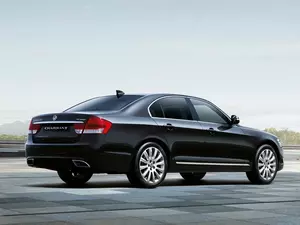
| Vehicle | Precise engine size | Difference from world average | Engine size to consumption ratio | Horsepower from 1 L | Engine size to 100 kg of weight |
|---|---|---|---|---|---|
| 2.8 |
2.8 L (2799 cc) |
19.3% bigger | 147 cc to 1 mpg | 70 hp from 1 L | 147 cc to 100 kg |
| 3.6 |
3.6 L (3598 cc) |
53.4% bigger | 189 cc to 1 mpg | 69 hp from 1 L | 171 cc to 100 kg |
| 3.2 |
3.2 L (3199 cc) |
36.4% bigger | 168 cc to 1 mpg | 70 hp from 1 L | 168 cc to 100 kg |
| 5.0 V8 |
4.97 L (4966 cc) |
111.7% bigger | 276 cc to 1 mpg | 62 hp from 1 L | 248 cc to 100 kg |
| Vehicle | 2.8 |
|---|---|
| Precise engine size | 2.8 L (2799 cc) |
| Difference from world average | 19.3 bigger |
| Engine size to consumption ratio | 147 cc to 1 mpg |
| Horsepower from 1 L | 70 hp from 1 L |
| Engine size to 100 kg of weight | 147 cc to 100 kg |
| Vehicle | 3.6 |
| Precise engine size | 3.6 L (3598 cc) |
| Difference from world average | 53.4 bigger |
| Engine size to consumption ratio | 189 cc to 1 mpg |
| Horsepower from 1 L | 69 hp from 1 L |
| Engine size to 100 kg of weight | 171 cc to 100 kg |
| Vehicle | 3.2 |
| Precise engine size | 3.2 L (3199 cc) |
| Difference from world average | 36.4 bigger |
| Engine size to consumption ratio | 168 cc to 1 mpg |
| Horsepower from 1 L | 70 hp from 1 L |
| Engine size to 100 kg of weight | 168 cc to 100 kg |
| Vehicle | 5.0 V8 |
| Precise engine size | 4.97 L (4966 cc) |
| Difference from world average | 111.7 bigger |
| Engine size to consumption ratio | 276 cc to 1 mpg |
| Horsepower from 1 L | 62 hp from 1 L |
| Engine size to 100 kg of weight | 248 cc to 100 kg |

| Vehicle | Precise engine size | Difference from world average | Engine size to consumption ratio | Horsepower from 1 L | Engine size to 100 kg of weight |
|---|---|---|---|---|---|
| CM400 2.3 i 16V |
2.3 L (2295 cc) |
2.2% smaller | - | 65 hp from 1 L | 135 cc to 100 kg |
| CM600 L 3.2 i 24V |
3.2 L (3199 cc) |
36.4% bigger | - | 69 hp from 1 L | 178 cc to 100 kg |
| CM500 2.8 i 24V |
2.8 L (2799 cc) |
19.3% bigger | - | 70 hp from 1 L | 165 cc to 100 kg |
| CM600S 3.2 i 24V |
3.2 L (3199 cc) |
36.4% bigger | - | 69 hp from 1 L | 188 cc to 100 kg |
| Vehicle | CM400 2.3 i 16V |
|---|---|
| Precise engine size | 2.3 L (2295 cc) |
| Difference from world average | 2.2 smaller |
| Engine size to consumption ratio | - |
| Horsepower from 1 L | 65 hp from 1 L |
| Engine size to 100 kg of weight | 135 cc to 100 kg |
| Vehicle | CM600 L 3.2 i 24V |
| Precise engine size | 3.2 L (3199 cc) |
| Difference from world average | 36.4 bigger |
| Engine size to consumption ratio | - |
| Horsepower from 1 L | 69 hp from 1 L |
| Engine size to 100 kg of weight | 178 cc to 100 kg |
| Vehicle | CM500 2.8 i 24V |
| Precise engine size | 2.8 L (2799 cc) |
| Difference from world average | 19.3 bigger |
| Engine size to consumption ratio | - |
| Horsepower from 1 L | 70 hp from 1 L |
| Engine size to 100 kg of weight | 165 cc to 100 kg |
| Vehicle | CM600S 3.2 i 24V |
| Precise engine size | 3.2 L (3199 cc) |
| Difference from world average | 36.4 bigger |
| Engine size to consumption ratio | - |
| Horsepower from 1 L | 69 hp from 1 L |
| Engine size to 100 kg of weight | 188 cc to 100 kg |